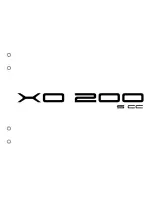
J/133 OWNER GUIDE
44
Storage Tips
Many of the maintenance problems surrounding boats can be pinpointed during the end-
of-season haul-out. This is the time when a careful inspection will reveal the ravages of a
long summer. If you live in colder climates, it is also the time to prepare the boat for what
might be an even more brutal winter ashore.
First, clean your boat as thoroughly as possible. Get the yard to use a high-powered hose
to clean off most of the growth before it dries onto the bottom paint. You may have to use
a scrub brush and putty knife for heavy growth, like barnacles, and for areas around the
propeller and shaft and underneath the keel.
Rigging
Sails and lines should be removed at the end of each season, rinsed thoroughly in fresh
water and stored in a warm, dry place. This will prolong their useful life as mildew can
affect even today’s synthetic materials. Most sail lofts offer a cleaning/storage service.
Engine
Check the engine owner’s manual for maintenance guidance during the season and for
the specific haul out procedures necessary to winterize the engine. Fill fuel tank to
minimize condensation and add an anti-bacterial agent. In the exhaust system, water can
accumulate in the bottom of the muffler. This should be drained using the drain plug, or
anti-freeze added so residual water doesn’t freeze.
Batteries
It is preferable to remove the batteries and store in a heated area, recharging periodically
to maintain full charge status. If you are in warmer climates, it is possible to leave the
batteries aboard. Simply check them once a month to ensure they remain charged.
Head
Read the owner’s manual for specific maintenance procedures. Generally, you will want
to drain all water and replace with an anti-freeze agent. To maintain the lubrication of its
internal seals, flush through a light oil. Again, follow the manufacturer’s recommendations
for winter maintenance.
Water System
Drain all tanks and ensure it is also drained from between the heater and the check valve
installed in the supply line. Add an anti-freeze solution specifically designed for marine
potable water systems to the residual water in the water tanks, and pump with manual and
pressure pumps until all lines are full of anti-freeze solution.
DO NOT use automotive radiator-type anti-freeze, as most are poisonous and may
damage the plumbing.
Bilges
Pump bilges completely dry and use a strong cleaning solvent to eliminate odors and
bacteria.
Electronics
Remove as many as possible to avoid condensation caused by the extreme rise and fall of
temperature and humidity that come with winter.
Summary of Contents for 133
Page 1: ......
Page 2: ...J 133 OWNER GUIDE 2 J 133 Owner Guide Yacht Name Owner Name COPYRIGHT J BOATS INC 2004...
Page 11: ...J 133 OWNER GUIDE 12 Diagrams Layouts Schematics DeckHardwareLayout...
Page 12: ...J 133 OWNER GUIDE 13 Mainsheet TravelerDiagram...
Page 13: ...J 133 OWNER GUIDE 14 HalyardLayout...
Page 14: ...J 133 OWNER GUIDE 15 ReefingSystemDiagram...
Page 15: ...J 133 OWNER GUIDE 16 SteeringSystem...
Page 16: ...J 133 OWNER GUIDE 17 Engine ExhaustSystemLayout...
Page 17: ...J 133 OWNER GUIDE 18 FuelSystemLayout...
Page 18: ...J 133 OWNER GUIDE 19 Thru HullLocations...
Page 19: ...J 133 OWNER GUIDE 20 FreshWaterSystemSchematic...
Page 21: ...J 133 OWNER GUIDE 22 DC ACDistributionPanels...
Page 22: ...J 133 OWNER GUIDE 23 DCComponentLayout...
Page 23: ...J 133 OWNER GUIDE 24 StandardDCWiringSchematic...
Page 24: ...J 133 OWNER GUIDE 25 DCLink2000 MeterChargingSystem...
Page 25: ...J 133 OWNER GUIDE 26 DCChargingSystem w optionalinverter...
Page 27: ...J 133 OWNER GUIDE 28 ACSchematicwithOptionalInverter...
Page 28: ...J 133 OWNER GUIDE 29 PropaneSystemLayout...


































